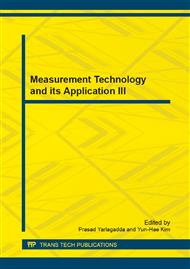[1]
K.C. Laudon and C.G. Traver: E-Commerce Business, Technology, Society. Fifth Edition. Upper Saddle River, New Jersey: Prentice Hall, Inc, (2009).
Google Scholar
[2]
V.B. Hoo, K. Kueh and M.Z.M. Zawawi: Measuring Website Service Quality for Malaysian Companies (2009). http: /www. scribd. com/doc/13407627/Measuring-Websit [2010, August 13].
Google Scholar
[3]
Indrawati, M. Raman, and K.W. Chew: A Conceptual Model for Behavioral Intention to Use 3G Mobile Multimedia Services in Indonesia. Proceedings of International Symposium on Information Technology 2010, Kuala Lumpur, Malaysia. 15th – 17th June (2010).
DOI: 10.1109/itsim.2010.5561347
Google Scholar
[4]
Indrawati, S. Murugesan, and M. Raman: A New Conceptual Model of Mobile Multimedia Service (MMS) and 3G Network Adoption in Indonesia, International Journal of Information Science and Management (2010a), pp.49-63.
Google Scholar
[5]
Indrawati, S. Murugesan, and M. Raman, M.: 3G Mobile Multimedia Services (MMS) Utilization in Indonesia: an Exploratory Research, Proceedings of the 2010 IEEE International Symposium on Technology and Society, Australia, 7th and 9th June (2010b), pp.145-155.
DOI: 10.1109/istas.2010.5514644
Google Scholar
[6]
Indrawati: Behavioral Intention to Use 3G Mobile Multimedia Services in Indonesia, Doctoral Dissertation, Multimedia University (2012).
Google Scholar
[7]
V. Venkatesh, M.G. Morris, G.B. Davis, and F.D. Davis: User acceptance of information technology: toward a unified view. MIS Quarterly, (27)3, (2003), pp.425-478.
DOI: 10.2307/30036540
Google Scholar
[8]
Y. Dwivedi and Z. Irani: Understanding the Adopters and Non-Adopters of Broadband. Communication of the ACM, 52(1), pp.122-125 (2009).
DOI: 10.1145/1435417.1435445
Google Scholar
[9]
F.D. Davis, R.P. Bagozzi and P.R. Warshaw: User acceptance of Computer Technology: A comparison of Two Theoretical Models, Management Science, 35(8), (1989). P. 982-1003.
DOI: 10.1287/mnsc.35.8.982
Google Scholar
[10]
I. Ajzen: The theory of planned behavior. Organizational Behavior and Human Decision Process 50 (1991). Available: http: /www. courses. umass. edu/psyc661/pdf [2009, February 25].
Google Scholar
[11]
M. Fishbein and I. Ajzen Belief, attitude, intention, and behavior : An introduction to theory and research (1975). Available: http: /people. umass. edu/aizen/f&a1975. html [2009, February 25].
Google Scholar
[12]
R.L. Thompson, C.A. Higgins and J.M. Howell Personal computing: Toward a conceptual model of utilization. MIS Quarterly, 15 (1), (1991), pp.125-143.
DOI: 10.2307/249443
Google Scholar
[13]
N.M. Daud: Factors Determining Intranet Usage: an Empirical Study of Middle Managers in Malaysian Port Industry. Doctoral Dissertation, Multimedia University, Malaysia (2008).
Google Scholar
[14]
B.C. Glassberg: Individual Use of web technology: a reconceptualization and empirical test of the technology acceptance model. Dissertation International, 61(07), (2000).
Google Scholar
[15]
J.F. Hair, W.C. Black, J.B. Babin and R.E. Anderson: Multivariate Data Analysis, A Global Persepctive. Seventh Edition, Upper Saddle River, New Jersey: Pearson Education, Inc, (2010).
Google Scholar
[16]
U. Sekaran and R. Bougie: Research Method for Business, A Skill Building Approach. Fifth Edition John Wiley & Sons Inc., Singapore (2010).
Google Scholar
[17]
G.A. Churchil and D. Iacobucci: Marketing Research Methodological Foundations. Ninth Edition. South-Western: Thomson Corporation (2005).
Google Scholar
[18]
K,W. Chew: Modified Technology Acceptance Models as a Predictor of Online Purchase Behavior : a Malaysian Perspective (Doctoral Dissertation, Multimedia University (2007).
Google Scholar
[19]
W.W. Chin and J. Dibbern: An Introduction to a Permutation Based Procedure for Multi-Group PLS Analysis. In V.E. Vinzi, W.W. Chin, J. Henseler, H. Wang (Eds. ), Hanbook of Partial Least Squares Concepts, Methods, and Application. (p.171 – 193). Berlin: Springer (2010).
DOI: 10.1007/978-3-540-32827-8_8
Google Scholar
[20]
J. Henseler, C.M. Ringle and R.R. Sinkovics: The Use of Partial Least Squares Path Modeling in International Marketing. In R.R. Sinkovics, P.N. Ghauri (Ed. ) New Challenges to International Marketing (Advances in International Marketing, Volume 20) pp.277-319 (2009).
DOI: 10.1108/s1474-7979(2009)0000020014
Google Scholar
[21]
N. Urbach and F. Ahlemann: Structural Equation Modeling in Information Systems Research Using Partial Least Squares. Journal of Information Technology Theory and Application. 11(2), pp.5-40 (2010).
Google Scholar
[22]
N.K. Malhotra: Marketing Research an Applied Orientation, Third Edition. Upper Saddle River, New Jersey: Prentice Hall, Inc, (1999).
Google Scholar
[23]
C.M. Ringle, S. Wende and A. Will: SmartPLS 2. 0 (beta) [Online]. Available: www. smartpls. de. [2009, March 13]. (2005).
Google Scholar
[24]
Dapper, G. (2007) User acceptance of Enterprise 2. 0 A case study at an internationally operating private bank Available: http: /www. google. co. id/#hl =id&q=utaut+model &start=90&sa=N&fp=983862b504061180 [2009, April 9].
Google Scholar
[25]
P. Stephan, W. Patrick, M. Koen and V.S. Ed: Modeling Educational Technology Acceptance and Satisfaction. Proceedings of EDULEARN09 Conference. 6th-8th July 2009, Barcelona Spain.
Google Scholar


